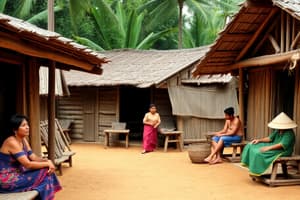Podcast
Questions and Answers
What was the primary cause of disease believed by early Filipinos?
What was the primary cause of disease believed by early Filipinos?
- Poor diet and nutrition
- Exposure to the elements
- Lack of medical care
- Supernatural forces or evil spirits (correct)
What was the role of the 'babaylan' or 'albularyo' during the Spanish era?
What was the role of the 'babaylan' or 'albularyo' during the Spanish era?
- They were researchers investigating new cures
- They were teachers of nursing practices
- They were priest-physicians who attended to the sick (correct)
- They were hospital administrators
Which hospital was founded by Governor Francisco de Sande and established in 1577?
Which hospital was founded by Governor Francisco de Sande and established in 1577?
- San Juan De Dios Hospital
- San Lazaro Hospital
- Hospital Real de Manila (correct)
- Hospital de Indios
Which hospital was exclusive for patients with leprosy?
Which hospital was exclusive for patients with leprosy?
What was the focus of nursing practice during the Spanish era?
What was the focus of nursing practice during the Spanish era?
When was the Hospital de Aguas established?
When was the Hospital de Aguas established?
Who founded the Laguna San Juan De Dios Hospital?
Who founded the Laguna San Juan De Dios Hospital?
Which prominent figure converted their house into quarters for Filipino soldiers during the Philippine-American War?
Which prominent figure converted their house into quarters for Filipino soldiers during the Philippine-American War?
When was the first Nurses Board examination held in the Philippines?
When was the first Nurses Board examination held in the Philippines?
Which hospital school of nursing was the first to train Filipino nurses?
Which hospital school of nursing was the first to train Filipino nurses?
Flashcards are hidden until you start studying
Study Notes
Early Filipino Nursing and Hospitals
- Hospital de Aguas was established in 1590 in Laguna, making it one of the oldest hospitals in the Philippines.
- San Juan De Dios Hospital was founded in 1596 by the brotherhood of Misericordia, providing general health services to the public.
Prominent Women in the Philippine Revolution
- Josephine Bracken, wife of Jose Rizal, installed a field hospital in Tejeros to provide nursing care to wounded soldiers.
- Rose Sevilla de Alvaro converted her house into a quarter for Filipino soldiers during the Phil-American War in 1899.
- Hilaria de Aguinaldo, wife of Emilio Aguinaldo, organized the Filipino Red Cross.
- Doña Maria Agoncillo de Aguinaldo, second wife of Emilio Aguinaldo, provided care to Filipino soldiers during the revolution.
- Melchora Aquino (Tandang Sora) nursed wounded Filipino soldiers, gave them shelter and food.
- Agueda Kahabagan, a revolutionary leader in Laguna, provided nursing services to her troops.
- Trinidad Tecson (Ina ng biak na Bato) stayed in the hospital at Biak na Bato to care for wounded soldiers.
Development of Nursing Education in the Philippines
- In 1907, the Americans trained the first Filipino nurses, establishing the St. Luke’s Hospital and its school of nursing with three students.
- The Pensionado Act of 1903 allowed Filipino nursing students to study in the United States of America.
- The Iloilo Mission Hospital Training School of Nursing was the first hospital to train Filipino nurses.
- In 1944, the first Nurses Board examination was held in Iloilo Mission Hospital.
- St. Paul Hospital School of Nursing was established in 1907 by the Archbishop of Manila, Jeremiah Harty.
- Mary Johnston Hospital School of Nursing was established in 1907, initially as a dispensary clinic for women and children.
Early Filipino Beliefs and Health Practices
- Early Filipinos believed that health and sickness were interrelated with superstitious beliefs and practices.
- Diseases were believed to be caused by another person or evil spirits, and treatment involved driving away evil spirits through prayer, rituals, and superstitions.
- Special gods of healing, such as priest-physicians, witch doctors, and herbolarios, were believed to possess the power to drive away demons.
Spanish Era Hospitals and Nursing Practices
- During the Spanish era, religious orders built hospitals across the Philippines to care for the sick.
- Nursing practices focused on nutrition, wound care, and caring for the ill, with priest-physicians and male nurses assisting Friars in hospitals.
Studying That Suits You
Use AI to generate personalized quizzes and flashcards to suit your learning preferences.




